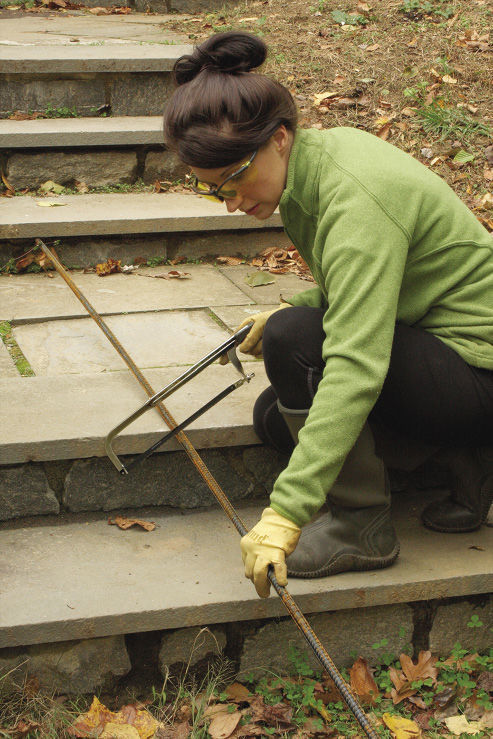
Gardeners love arbors. Admit it: Once you’ve filled your cart with assorted plants at the nursery, you can’t help but wheel the cart past the department with all the arbors—and drool. For many years, I’ve dreamed of having a unique arbor to frame a walkway, mark the entrance to a special spot in the garden, or elegantly signal a transition to another part of the landscape. And I would have purchased one a decade ago except for one fact: Arbors are expensive. Most gardeners would rather spend the big bucks on plants. But with a little muscle and some imagination, you can build a simple arbor out of rebar for about $100. The best part is that the only power tools you’ll need are your own two hands. Turn the page to see how it’s done.
Materials:
• Protective gloves
• Eight 10-foot lengths of rebar
• Tape measure
• Masking tape
• Heavy gauge (#40) wire
• Wire cutters
• Seventeen 4-foot lengths of rebar
An Amazing Arbor in Five Simple Steps
1. Mark the bars for bending

Measure 2 feet in from one end of each 10-foot length of rebar, and mark that spot with a piece of masking tape.
2. Use a tree to shape the bars

Bend each piece of rebar around a tree trunk at the 2-foot mark to form an arch.
3. Wire the arches together to form the frame

Push two of the bent-rebar lengths at least 1 foot into the ground, opposite each other. The arched ends should slightly overlap at the top. Bind the overlapping ends together with a piece of wire. Repeat with the remaining 10-foot lengths of rebar, spacing the four resulting arches about 16 inches apart.
4. Attach the top crossbar

To give the frame stability, place a 4-foot-long piece of rebar across the top center of the arches, and wire it in place.
5. Secure the remaining crossbars

Use the final 16 4-foot lengths of rebar to form horizontal crossbars. Use eight pieces on each side, spacing them an equal distance apart. Secure them with wire wherever two bars cross.
Construction Tip

A hacksaw can come in handy
Rebar is sold in several different lengths. But if you are having trouble finding short bars, you can use a hacksaw outfitted with a metal-cutting blade to trim the pieces down to size. Rebar is made out of a fairly soft metal, so it cuts easily.
Vines Complete the Look

Many ornate arbors are beautiful as stand-alone pieces of garden art. But because a rebar arbor is fairly rustic and simple, you’ll want to plant some fast-growing vines at its base to polish its appearance. The following three annual vines, when planted together, will help fill in your arbor quickly (usually within two months). But if you have more patience than I do, you can plant only one or two of these options and let them fill in over the course of an entire season. These one-season wonders will cohabitate nicely with perennial vines, too, filling in the blank canvas while the slower-growing staples size up.
1. Cardinal climber (Ipomoea coccinea, annual)
2. Scarlet runner bean (Phaseolus coccineus, annual)
3. ‘Grandpa Ott’s’ morning glory (Ipomoea purpurea ‘Grandpa Ott’s’, annual)
Danielle Sherry is the senior editor.
Photos: Danielle Sherry. Illustration: Martha Garstang Hill
Fine Gardening Recommended Products

Gardener's Log Book from NYBG
Fine Gardening receives a commission for items purchased through links on this site, including Amazon Associates and other affiliate advertising programs.

A.M. Leonard Deluxe Soil Knife & Leather Sheath Combo
Fine Gardening receives a commission for items purchased through links on this site, including Amazon Associates and other affiliate advertising programs.




















Comments
Log in or create an account to post a comment.
Sign up Log in